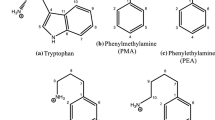Abstract
The accuracy of molecular dynamics (MD) simulations is limited by the availability of parameters for the molecular system of interest. In most force fields, parameters of common chemical groups are already present. With the development of novel small organic molecules as probes to study biological systems, more chemical groups require parameterization. An azide group is often used in studies of biological systems but computational studies are still impeded by the lack of parameters. In this paper, we present a set of molecular mechanics (MM) parameters for aromatic and aliphatic azido groups, and their application in MD simulations of a photoaffinity probe currently used in our laboratory for mapping binding modes available in the active site of histone deacetylases. The parameters were developed for the generalized Amber force field (GAFF) using density functional theory (DFT) calculations at B3LYP 6-311G(d) level. The parameters were validated by geometry optimization and MD simulations.







Similar content being viewed by others
References
He B et al (2009) Photolabeling probes for mapping the multiple binding poses of HDAC inhibitors. In: Abstract of papers of AACR-ACS Chemistry in Cancer Research: A Vital Partnership in Cancer Drug Discovery and Development. New Orleans, LA, p A5
Kouzarides T (1999) Histone acetylases and deacetylases in cell proliferation. Curr Opin Genet Dev 9:40–48
Archer SY, Hodin RA (1999) Histone acetylation and cancer. Curr Opin Genet Dev 9:171–174
Cress WD, Seto E (2000) Histone deacetylases, transcriptional control, and cancer. J Cell Physiol 184:1–16
Mahlknecht U, Ottmann OG, Hoelzer D (2000) When the band begins to play: histone acetylation caught in the crossfire of gene control. Mol Carcinog 27:268–271
Hahnen E et al (2008) Histone deacetylase inhibitors: possible implications for neurodegenerative disorders. Expert Opin Investig Drugs 17:169–184
Kozikowski AP et al (2007) Functional differences in epigenetic modulators—superiority of mercaptoacetamide-based histone deacetylase inhibitors relative to hydroxamates in cortical neuron neuroprotection studies. J Med Chem 50:3054–3061
Carvalho ATP, Fernandes PA, Ramos MJ (2007) Parameterization of AZT—a widely used nucleoside inhibitor of HIV-1 reverse transcriptase. Int J Quantum Chem 107:292–298
Cornell WD et al (1995) A second generation force field for the simulation of proteins, nucleic acids, and organic molecules. J Am Chem Soc 117:5179–5197
Wang J et al (2004) Development and testing of a general amber force field. J Comput Chem 25:1157–1174
Dennington R II et al (2003) GaussView. Semichem Inc, Shawnee Mission, KS
Frisch MJ et al (2004) Gaussian 03, Revision C.02. Gaussian Inc, Wallingford, CT
Berendsen HJC, Spoel Dvd, Drunen Rv (1995) GROMACS: a message-passing parallel molecular dynamics implementation. Comp Phys Commun 91:43–56
Lindal E, Hess B, Spoel Dvd (2001) GROMACS 3.0: a package for molecular simulation and trajectory analysis. J Mol Model 7:306–317
van der Spoel D et al (2001) Gromacs User Manual Version 3.0. Nijenborgh, Groningen, Netherlands. Internet: http://www.gromacs.org
van der Spoel D et al (2005) Gromacs: fast, flexible and free. J Comput Chem 26:1701–1718
Wang J et al (2006) Automatic atom type and bond type perception in molecular mechanical calculations. J Mol Graphics Modell 25:247–260
Sorin EJ, Rhee YM, Pande VS (2005) Does water play a structural role in the folding of small nucleic acids? Biophys J 88:2516–2524
Jorgensen WL et al (1983) Comparison of simple potential functions for simulating liquid water. J Chem Phys 79:926–935
Hess B et al (1997) LINCS: a linear constraint solver for molecular simulations. J Comput Chem 18:1463–1472
Miyamoto S, Kollman PA (1992) SETTLE: an analytical version of the SHAKE and RATTLE algorithms for rigid water models. J Comput Chem 13:952–962
Berendsen HJC et al (1984) Molecular dynamics with coupling to an external bath. J Chem Phys 81:3684–3690
Darden T, York D, Pedersen L (1993) Particle mesh Ewald: An N-log(N) method for Ewald sums in large systems. J Chem Phys 98:10089–10092
Anderson DWW, Rankin DWH, Robertson A (1972) Electron diffraction determination of the molecular structures of methylazide, methylisocyanate and methylisothiocyanate in the gas phase. J Mol Structure 14:385–396
Winnewisser BP (1980) The substitution structure of hydrazoic acid, HNNN. J Mol Spectrosc 82:220–223
Klaeboe P et al (1986) The vibrational spectra, molecular structure and conformation of organic azides. Part I. A survey. J Mol Struct 141:161–172
McQuaid MJ, Sun H, Rigby D (2004) Development and validation of COMPASS force field parameters for molecules with aliphatic azide chains. J Comput Chem 25:61–71
Cross JB et al (2002) The active site of a zinc-dependent metalloproteinase influences the computed pK(a) of ligands coordinated to the catalytic zinc ion. J Am Chem Soc 124:11004–11007
Acknowledgments
We would like to thank Dr. Michael Brünsteiner for critical analysis of the manuscript. This study was funded in part by the Breast Cancer Congressionally Directed Research Program of Department of Defense Idea Award BC051554 and by the National Cancer Institute/NIH grant 1R01 CA131970-01A1. We also thank OpenEye Scientific Software for providing academic license for modeling software.
Author information
Authors and Affiliations
Corresponding author
Electronic Supplementary Material
Below is the link to the electronic supplementary material:
Supplementary Information
(DOC 55.0 KB)
Rights and permissions
About this article
Cite this article
Pieffet, G., Petukhov, P.A. Parameterization of aromatic azido groups: application as photoaffinity probes in molecular dynamics studies. J Mol Model 15, 1291–1297 (2009). https://doi.org/10.1007/s00894-009-0488-z
Received:
Accepted:
Published:
Issue Date:
DOI: https://doi.org/10.1007/s00894-009-0488-z




